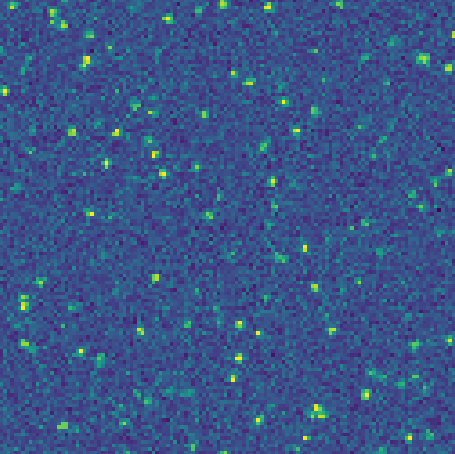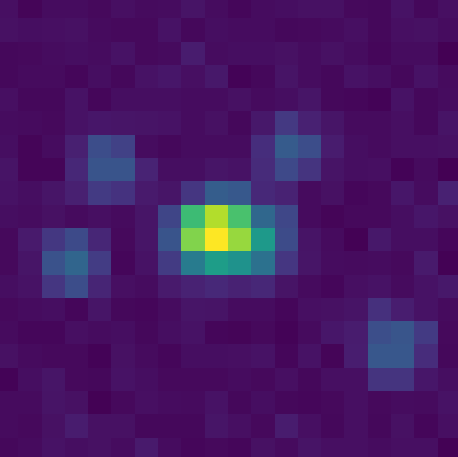Image simulation
Functions used to simulate spot images, in 2D and 3D.
Simulation is performed in three steps:
We simulate ground truth coordinates.
From an empty frame we simulate a gaussian signal in every spot location.
We add an additive background noise in image if needed.
The full process can be run with:
- simfish.simulate_ground_truth(ndim, n_spots, random_n_spots=False, n_clusters=0, random_n_clusters=False, n_spots_cluster=0, random_n_spots_cluster=False, centered_cluster=False, frame_shape=(128, 128), voxel_size=(100, 100), sigma=(150, 150), random_sigma=0.05, amplitude=5000, random_amplitude=0.05, probability_map=None)
Simulate ground truth information about the simulated spots like their coordinates, standard deviations and amplitude.
- Parameters
- ndim{2, 3}
Number of dimension to consider for the simulation.
- n_spotsint
Expected number of spots to simulate.
- random_n_spotsbool, default=False
Make the number of spots follow a Poisson distribution with expectation n_spots, instead of a constant predefined value.
- n_clustersint
Expected number of clusters to simulate.
- random_n_clustersbool, default=False
Make the number of clusters follow a Poisson distribution with expectation n_clusters, instead of a constant predefined value.
- n_spots_clusterint
Expected number of spots to simulate per cluster.
- random_n_spots_clusterbool, default=False
Make the number of spots follow a Poisson distribution with expectation n_spots_cluster, instead of a constant predefined value.
- centered_clusterbool, default=False
Center the simulated cluster. Only used if one cluster is simulated.
- frame_shapetuple or list, default=(128, 128)
Shape (z, y, x) or (y, x) of the image to simulate.
- voxel_sizeint or float or tuple or list, default=(100, 100)
Size of a voxel, in nanometer. One value per spatial dimension (zyx or yx dimensions). If it’s a scalar, the same value is applied to every dimensions.
- sigmaint or float or tuple or list, default=(150, 150)
Standard deviation of the spot, in nanometer. One value per spatial dimension (zyx or yx dimensions). If it’s a scalar, the same value is applied to every dimensions.
- random_sigmaint or float, default=0.05
Sigmas follow a normal distribution around the provided sigma values. The scale used is:
\[\mbox{scale} = \mbox{sigma} * \mbox{random_sigma}\]- amplitudeint or float, default=5000
Intensity of the spot.
- random_amplitudeint or float, default=0.05
Margin allowed around the amplitude value. The formula used is:
\[\mbox{margin} = \mbox{amplitude} * \mbox{random_amplitude}\]- probability_mapnp.ndarray, np.float32, optional
Probability map to sample spots coordinates with shape (z, y, x).
- Returns
- ground_truthnp.ndarray, np.float64
Ground truth array with shape (nb_spots, 6) or (nb_spots, 4). Columns are:
Coordinate along the z axis (optional).
Coordinate along the y axis.
Coordinate along the x axis.
Standard deviation of the spot along the z axis (optional).
Standard deviation of the spot in the yx plan.
Intensity of the spot.
- simfish.add_spots(image, ground_truth, voxel_size, precomputed_gaussian=None)
Simulate gaussian spots based on the ground truth coordinates.
- Parameters
- imagenp.ndarray
Image with shape (z, y, x) or (y, x).
- ground_truthnp.ndarray, np.float64
Ground truth array with shape (nb_spots, 6) or (nb_spots, 4). Columns are:
Coordinate along the z axis (optional).
Coordinate along the y axis.
Coordinate along the x axis.
Standard deviation of the spot along the z axis (optional).
Standard deviation of the spot in the yx plan.
Intensity of the spot.
- voxel_sizeint or float or tuple or list
Size of a voxel, in nanometer. One value per spatial dimension (zyx or yx dimensions). If it’s a scalar, the same value is applied to every dimensions.
- precomputed_gaussiansequence of array_like, optional
Sequence with tables of precomputed values for the erf, with shape (nb_value, 2). One table per dimension.
- Returns
- image_with_spotsnp.ndarray
A 3-d or 2-d image with simulated spots and shape (z, y, x) or (y, x).
- simfish.add_white_noise(image, noise_level, random_noise=0.05)
Generate and add white noise to an image.
- Parameters
- imagenp.ndarray
Image with shape (z, y, x) or (y, x).
- noise_levelint or float
Reference level of noise background to add in the image.
- random_noiseint or float, default=0.05
Background noise follows a normal distribution around the provided noise values. The scale used is:
\[\mbox{scale} = \mbox{noise_level} * \mbox{random_noise}\]
- Returns
- noised_imagenp.ndarray
Noised image with shape (z, y, x) or (y, x).
- simfish.simulate_images(n_images, ndim, n_spots, random_n_spots=False, n_clusters=0, random_n_clusters=False, n_spots_cluster=0, random_n_spots_cluster=False, centered_cluster=False, image_shape=(128, 128), image_dtype=<class 'numpy.uint16'>, subpixel_factors=None, voxel_size=(100, 100), sigma=(150, 150), random_sigma=0.05, amplitude=5000, random_amplitude=0.05, noise_level=300, random_noise=0.05)
Return a generator to simulate multiple ground truth coordinates and images of spots.
- Parameters
- n_imagesint
Number of images to simulate.
- ndim{2, 3}
Number of dimension to consider for the simulation.
- n_spotsint or tuple
Expected number of spots to simulate per image. If tuple, provide the minimum and maximum number of spots to simulate. Multiple images are simulated with a growing number of spots.
- random_n_spotsbool, default=False
Make the number of spots follow a Poisson distribution with expectation n_spots, instead of a constant predefined value.
- n_clustersint
Expected number of clusters to simulate.
- random_n_clustersbool, default=False
Make the number of spots follow a Poisson distribution with expectation n_clusters, instead of a constant predefined value.
- n_spots_clusterint
Expected number of spots per cluster to simulate.
- random_n_spots_clusterbool, default=False
Make the number of spots follow a Poisson distribution with expectation n_spots_cluster, instead of a constant predefined value.
- centered_clusterbool, default=False
Center the simulated cluster. Only used one cluster is simulated.
- image_shapetuple or list, default=(128, 128)
Shape (z, y, x) or (y, x) of the images to simulate.
- image_dtypedtype, default=np.uint16
Type of the image to simulate (np.uint8, np.uint16, np.float32 or np.float64).
- subpixel_factorstuple or list, optional
Scaling factors to simulate images with subpixel accuracy. First a larger image is simulated, with larger spots, then we downscale it. One element per dimension. Can make the simulation much longer. If None, spots are localized at pixel level.
- voxel_sizeint or float or tuple or list, default=(100, 100)
Size of a voxel, in nanometer. One value per spatial dimension (zyx or yx dimensions). If it’s a scalar, the same value is applied to every dimensions.
- sigmaint or float or tuple or list, default=(150, 150)
Standard deviation of the spot, in nanometer. One value per spatial dimension (zyx or yx dimensions). If it’s a scalar, the same value is applied to every dimensions.
- random_sigmaint or float, default=0.05
Sigmas follow a normal distribution around the provided sigma values. The scale used is:
\[\mbox{scale} = \mbox{sigma} * \mbox{random_sigma}\]- amplitudeint or float, default=5000
Intensity of the spot.
- random_amplitudeint or float, default=0.05
Margin allowed around the amplitude value. The formula used is:
\[\mbox{margin} = \mbox{amplitude} * \mbox{random_amplitude}\]- noise_levelint or float, default=300
Reference level of noise background to add in the image.
- random_noiseint or float
Background noise follows a normal distribution around the provided noise values. The scale used is:
\[\mbox{scale} = \mbox{noise_level} * \mbox{random_noise}\]
- Returns
- _Tuple generator
- imagenp.ndarray
Simulated image with spots and shape (z, y, x) or (y, x).
- ground_truthnp.ndarray, np.float64
Ground truth array with shape (nb_spots, 6) or (nb_spots, 4). Columns are:
Coordinate along the z axis (optional).
Coordinate along the y axis.
Coordinate along the x axis.
Standard deviation of the spot along the z axis (optional).
Standard deviation of the spot in the yx plan.
Intensity of the spot.
- simfish.simulate_image(ndim, n_spots, random_n_spots=False, n_clusters=0, random_n_clusters=False, n_spots_cluster=0, random_n_spots_cluster=False, centered_cluster=False, image_shape=(128, 128), image_dtype=<class 'numpy.uint16'>, subpixel_factors=None, voxel_size=(100, 100), sigma=(150, 150), random_sigma=0.05, amplitude=5000, random_amplitude=0.05, noise_level=300, random_noise=0.05)
Simulate ground truth coordinates and image of spots.
- Parameters
- ndim{2, 3}
Number of dimension to consider for the simulation.
- n_spotsint
Expected number of spots to simulate.
- random_n_spotsbool, default=False
Make the number of spots follow a Poisson distribution with expectation n_spots, instead of a constant predefined value.
- n_clustersint
Expected number of clusters to simulate.
- random_n_clustersbool, default=False
Make the number of spots follow a Poisson distribution with expectation n_clusters, instead of a constant predefined value.
- n_spots_clusterint
Expected number of spots per cluster to simulate.
- random_n_spots_clusterbool, default=False
Make the number of spots follow a Poisson distribution with expectation n_spots_cluster, instead of a constant predefined value.
- centered_clusterbool, default=False
Center the simulated cluster. Only used one cluster is simulated.
- image_shapetuple or list, default=(128, 128)
Shape (z, y, x) or (y, x) of the image to simulate.
- image_dtypedtype, default=np.uint16
Type of the image to simulate (np.uint8, np.uint16, np.float32 or np.float64).
- subpixel_factorstuple or list, optional
Scaling factors to simulate an image with subpixel accuracy. First a larger image is simulated, with larger spots, then we downscale it. One element per dimension. Can make the simulation much longer. If None, spots are localized at pixel level.
- voxel_sizeint or float or tuple or list, default=(100, 100)
Size of a voxel, in nanometer. One value per spatial dimension (zyx or yx dimensions). If it’s a scalar, the same value is applied to every dimensions.
- sigmaint or float or tuple or list, default=(150, 150)
Standard deviation of the spot, in nanometer. One value per spatial dimension (zyx or yx dimensions). If it’s a scalar, the same value is applied to every dimensions.
- random_sigmaint or float, default=0.05
Sigmas follow a normal distribution around the provided sigma values. The scale used is:
\[\mbox{scale} = \mbox{sigma} * \mbox{random_sigma}\]- amplitudeint or float, default=5000
Intensity of the spot.
- random_amplitudeint or float, default=0.05
Margin allowed around the amplitude value. The formula used is:
\[\mbox{margin} = \mbox{amplitude} * \mbox{random_amplitude}\]- noise_levelint or float, default=300
Reference level of noise background to add in the image.
- random_noiseint or float
Background noise follows a normal distribution around the provided noise values. The scale used is:
\[\mbox{scale} = \mbox{noise_level} * \mbox{random_noise}\]
- Returns
- imagenp.ndarray, np.uint
Simulated image with spots and shape (z, y, x) or (y, x).
- ground_truthnp.ndarray
Ground truth array with shape (nb_spots, 6) or (nb_spots, 4):
coordinate_z (optional)
coordinate_y
coordinate_x
sigma_z (optional)
sigma_yx
amplitude


